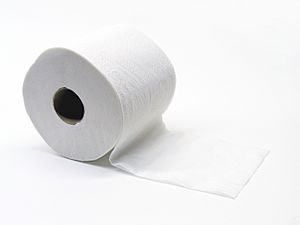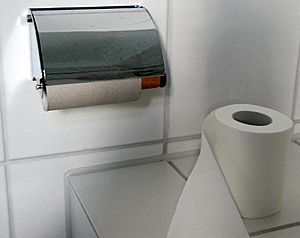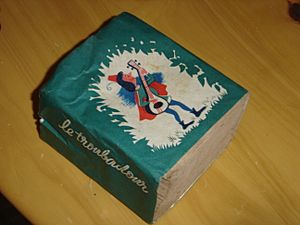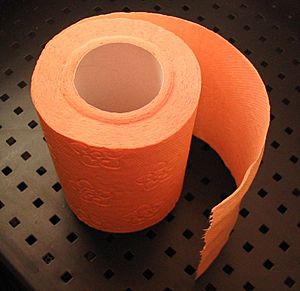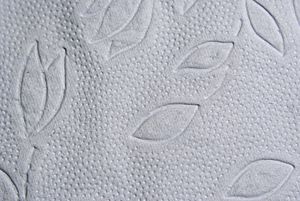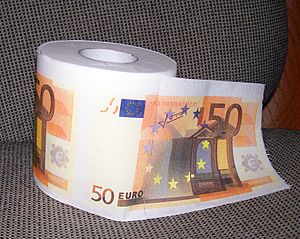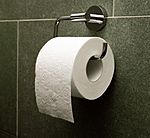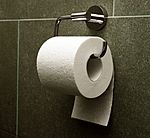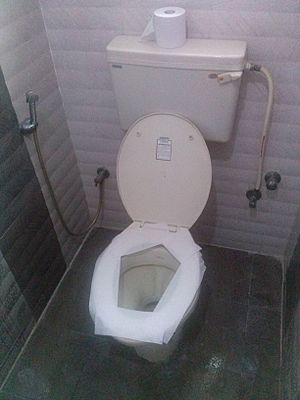Toilet paper facts for kids
Toilet paper is a soft paper product we use after going to the toilet. It helps us clean up after using the toilet and also keeps our hands clean. It usually comes as a long strip of paper with small tears (perforations) so you can easily pull off sheets. This strip is wrapped around a cardboard tube, which fits into a holder near the toilet. A whole roll of toilet paper is often called a toilet roll or loo roll in Britain.
People use toilet paper for other things too, since it's always around the house. It can be like a facial tissue for blowing your nose or wiping your eyes. You can also use it to wipe or soak up sweat. Sometimes, it's used for cleaning, like a softer paper towel. Kids sometimes use toilet paper for a harmless prank called "toilet papering," where they throw rolls of it over houses or trees, making a big, messy decoration!
Most modern toilet paper is made to break down easily in septic tanks (underground tanks that treat wastewater). Other types of paper, like facial tissues, might not break down as well. Wet toilet paper also breaks down quickly in nature. Toilet paper comes in different thicknesses, called "plies," from one to six layers. More layers mean it's stronger and soaks up more. Some people have a strong opinion about whether the roll should hang "over" or "under" on the dispenser!
People in China were using paper for hygiene as early as the 6th century AD. Special toilet paper was made in large amounts by the 14th century. Modern toilet paper, like we know it today, started in the 1800s. The first patent for a roll dispenser was given in 1883.
Contents
History of Toilet Paper
Paper was first used in China around 200 BC for wrapping and padding. But the first mention of using paper for toilet purposes was around 589 AD. A Chinese scholar named Yan Zhitui wrote that he wouldn't use paper with important writings on it for the toilet.
Later, in the Tang dynasty (618–907 AD), an Arab traveler visited China in 851 AD. He wrote that the Chinese didn't wash with water after using the toilet. Instead, they wiped themselves with paper.
By the early 1300s, a huge amount of toilet paper was being made in China. In one area alone, ten million packages of toilet paper were produced each year. Each package had 1,000 to 10,000 sheets! In 1393, during the Ming dynasty, records show that 720,000 sheets of toilet paper were made every year for the emperor's court in Nanjing. The emperor's family even had 15,000 special soft, perfumed sheets made just for them.
In other parts of the world, rich people used soft materials like wool or lace. Less wealthy people used whatever they could find. This included rags, wood shavings, leaves, grass, stones, sand, moss, water, snow, or even corncobs. What they used depended on where they lived and the local customs.
Toilet Paper as a Product
Joseph Gayetty is known for inventing modern toilet paper that was sold in stores in the United States. Gayetty's paper first came out in 1857. It was sold in flat sheets and had his name printed on it. Ads for his product called it "The greatest necessity of the age!"
Later, in 1883, Seth Wheeler from New York got the first patents for toilet paper rolls and dispensers. Toilet paper on rolls became very popular when the Scott Paper Company started selling it in 1890.
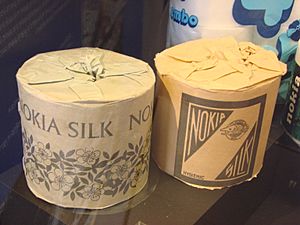
Making toilet paper soft and strong took a long time. Even in the 1930s, one company advertised that their toilet paper was "splinter free"! When flush toilets became common, people used more toilet paper. Thicker paper could clog the toilet's trap, which stops bad smells from coming up from the sewer. So, softer, thinner paper that broke down easily became important.
Softer, two-ply (two-layer) toilet paper was first sold in Britain in 1942. This became the famous Andrex brand.
Moist toilet paper, also called wet wipes, came out in the UK in the 1990s. Many people thought it cleaned better than dry toilet paper. However, these wipes often don't break down easily and can cause huge clogs called "fatbergs" in sewer pipes. Because of this, many cities now tell people not to flush wet wipes down the toilet.
Americans buy over seven billion rolls of toilet paper every year. On average, each American uses about 23.6 rolls per year.
In 1973, a TV host named Johnny Carson made a joke on his show about a possible toilet paper shortage. After his joke, people got worried and bought huge amounts of toilet paper. This actually caused a real shortage in the United States for several months!
More recently, during the COVID-19 pandemic in March 2020, many countries saw toilet paper shortages. This happened because people were worried and bought a lot of it at once. People didn't know how long they might have to stay home. Manufacturers actually made more toilet paper than usual. But because so many people were at home all the time, they used more home toilet paper. In some countries, people already used bidets (devices that spray water for cleaning). More Americans also became interested in bidets during this time.
In 2022, toilet paper packaging in Britain started showing bowel cancer symptoms. This was to help people learn about the signs of the disease. This idea came from a journalist named Deborah James, who later passed away from bowel cancer. Many people didn't know the main symptoms of bowel cancer, so this helped raise awareness.
What is Toilet Paper Like?
Toilet paper comes in many different types. It can have various patterns, decorations, and textures. Some toilet papers are even moistened or perfumed. But sometimes, fragrances can cause problems for people who are allergic to perfumes.
A typical modern toilet paper roll is about 10 centimeters (4 inches) wide and 12 centimeters (4.7 inches) across. It weighs about 227 grams (8 ounces). Sometimes, toilet paper comes as individual sheets packed in boxes, especially for public restrooms. There's also "hard" single-ply paper and soft multi-ply paper.
Sheet Size
The size of each toilet paper sheet, where it tears at the perforation, is different in various countries. In Germany, France, and Switzerland, a common size is about 100 × 140 mm (about the size of a postcard). In England, it's a bit wider, around 115 × 135 mm. In Thailand, it's often 115 × 102 mm.
In the United States, toilet paper sheets used to be about 4.5 inches by 4 inches. But since 1999, the size has been getting smaller. For example, Kimberly-Clark made their sheets shorter, and Scott made theirs even shorter in 2006. Now, a common size is about 3.7 inches long and 4.1 inches wide. You can still find larger sizes though.
Sheet Layers (Ply)
The "ply" of toilet paper means how many layers each sheet has. You can usually find rolls that are single-ply (one layer), 2-ply (two layers), 3-ply (three layers), or even 4-ply (four layers).
Roll Length
When you see "single roll," "double roll," "triple roll," or "mega roll" advertised, it means how many sheets are on the roll. Longer rolls don't need to be changed as often. But the very largest sizes might not fit in all toilet paper holders, especially in older homes.
Materials Used
Toilet paper is usually made from wood pulp from trees. But it can also be made from leftover parts of sugar cane or from bamboo.
Toilet paper products differ a lot in how they feel and work. Things like how rough or soft they are, how strong they are, and how much water they soak up are all important. Bigger companies do a lot of research to find out what people want in their toilet paper. Some modern toilet paper might have a light coating of aloe, lotion, or wax to make it feel softer.
The quality of toilet paper is usually judged by how many layers it has, how soft it is, and how strong it is. Cheap toilet paper, often used in public places, is usually one or two layers, very rough, and sometimes has small bits of unbleached paper in it. It used to be called "hard" toilet paper. Mid-grade toilet paper has two layers, is a bit textured for softness, and is stronger. Premium toilet paper can have lotion and wax, and has two to four layers of very finely made paper. If it's called "luxury," it might have patterns, be perfumed, colored, or treated with aloe.
To help the paper break down quickly in septic tanks or pipes, the paper fibers are shorter than those in facial tissues or writing paper. Manufacturers try to find a good balance: short fibers for quick breakdown, but long enough fibers to make the paper strong enough to use. If toilet paper gets too squished in a clog, it won't break down easily.
Color and Design
Colored toilet paper, like pink, blue, green, or yellow, was very popular in the United States starting in the 1960s. People could choose a color that matched their bathroom! By 2004, Scott was one of the last companies still making colored toilet paper, but they stopped producing it too.
However, colored toilet paper is still common in some European countries. You can find it in soft pastel colors like pink, apricot, light yellow, and light blue. Sometimes, you might even find pale purple or green. Very bright colors like black or neon green are rare. Toilet paper with flat printed designs is also not very common. If there's a print, it's usually in one color, like pink or blue.
Patterns and Motifs
Today, in the United States, plain colored toilet paper has mostly been replaced by white toilet paper with embossed (raised) decorative patterns. These patterns come in different colors and sizes depending on the brand. The patterns are usually "scatter patterns," meaning a design is spread out many times over the surface. Stripes and dots are rare. Sometimes, toilet paper has patterns like crocodiles, waves, circles, or checks. Some even have extra printing. The designs usually stand alone and don't continue from one sheet to the next.
Many patterns are related to "softness" and "fluffiness." You might see bears, cats, rabbits, feathers, or clouds. Other patterns relate to "lightness," like clouds, feathers, leaves, butterflies, or flying birds. Another common theme is pleasant smells, especially all kinds of flowers. Sometimes, you'll see designs that look fancy, like the French lily symbol. Designs related to water, like fish or seashells, are also sometimes used.
You can also find toilet paper with jokes, poems, or even pictures of money or politicians!
Texture
Toilet paper comes in different qualities. The cheapest kinds feel a bit like crêpe paper. They are often made from recycled materials. More expensive toilet papers are made from very absorbent, delicate paper. Toilet paper usually has a smooth surface. Sometimes, it's embossed (has a raised pattern) for a few reasons. Embossing can make the paper stronger. It can also help it clean more effectively. And of course, it's for design! In Switzerland, you often find toilet paper with bumps. In Germany, the number of layers (ply) is seen as a sign of quality. In the USA, Great Britain, and Japan, high-quality toilet paper is usually very soft and fine.
Additives
Some toilet papers are perfumed. Popular smells include chamomile, peach, or rose. Other toilet papers have special ingredients to fight bacteria.
How to Install Toilet Paper
Dispensers
A toilet roll holder, also called a toilet paper dispenser, is what holds the toilet paper roll. There are several types:
- A horizontal bar that swings out from a wall or door.
- A horizontal bar that is built into the wall.
- A vertical bar that is built into the wall.
- A horizontal bar on a stand that sits on the floor.
- A vertical pole on a base that sits on the floor.
- A unit mounted on the wall that holds more than one roll, often used in public restrooms.
- A wall-mounted unit that holds sheets of paper folded in a way that you can pull out one sheet at a time.
Some toilet paper for public places is wrapped around a cylinder many times, making it much thicker than a standard home roll.
Orientation
When you have a holder with a horizontal bar parallel to the wall, there are two ways to hang the toilet paper: the paper can hang over the top or under the bottom. Most people just do what they're used to. In surveys, about 60–70% of people prefer the over position. Many Americans think it should hang over the top, like a waterfall.
Decoration
Toilegami is a fun word for toilet paper origami. Just like fancy hotels might fold napkins on a table, some nice Japanese hotels fold the first few squares of toilet paper on the dispenser in a decorative way.
Fun Uses
In the United States, "TP-ing" (pronounced "tee-peeing") is a common prank. It's often done by teenagers. They throw rolls of toilet paper over cars, trees, houses, and gardens. The toilet paper unrolls and covers the property, making a big, messy, but temporary, decoration.
Young children and cats sometimes unroll an entire roll of toilet paper just by spinning it until it's all on the floor. Kids might also try to flush a whole roll down the toilet, piece by piece, without it breaking. Special toilet paper holders with an oval shape were invented to stop this from happening.
Other funny toilet paper pranks include musical holders that play an embarrassing song when you unroll the paper. You can also find custom toilet paper printed with jokes, stories, or even pictures of politicians!
How Toilet Paper Works (Mechanics)
Scientists have studied how toilet paper behaves when you pull on it, or when it gets wet or burns.
Toilet paper has also been used in physics education to show how things like torque (twisting force) and angular momentum (how things spin) work. It can also help explain how energy is conserved.
Caring for the Environment
One tree can make about 800 rolls of toilet paper. About 83 million rolls are made every day around the world! This means that 27,000 trees are used daily for toilet paper production.
More than seven billion rolls of toilet paper are sold in the United States each year. Americans use about 141 rolls per person per year. This is about 50% more than what people in other Western countries or Japan use. One reason for this higher use might be that people in other countries often use bidets or spray hoses to clean themselves. Cutting down millions of trees in North and South America for toilet paper raises concerns about our ecological footprint (the impact we have on the environment).
As of 2009, between 22% and 48% of the toilet paper used in the United States came from tree farms. The rest mostly came from older forests that had been cut before, and some even from very old, untouched forests.
Other Materials for Toilet Paper
Toilet paper made from recycled paper helps the environment because it means fewer trees need to be cut down. You can buy recycled toilet paper in stores. However, recycled newspaper can sometimes contain a chemical called BPA, which can affect hormones.
Toilet paper made from bamboo is also available. It can be better for the environment than paper from new trees because bamboo grows much faster. This means it needs less land and less water. For people in North America, some environmental groups suggest using recycled tree pulp over bamboo toilet paper. This is because tree forests support more different kinds of plants and animals, and bamboo products have to be shipped from Asia.
Toilet paper made from bagasse is another option. Bagasse is a leftover material from sugarcane after the sugar is taken out. This type of toilet paper doesn't require cutting down any new plants, since sugarcane is already grown for sugar.
The most environmentally friendly way to clean yourself is to use only soap and water.
See also
 In Spanish: Papel higiénico para niños
In Spanish: Papel higiénico para niños


